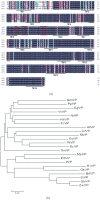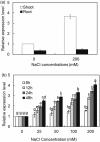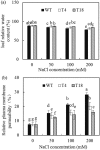Molecular cloning and functional characterisation of an H+-pyrophosphatase from Iris lactea
- PMID: 29259318
- PMCID: PMC5736642
- DOI: 10.1038/s41598-017-18032-3
Molecular cloning and functional characterisation of an H+-pyrophosphatase from Iris lactea
Abstract
Tonoplast H+-pyrophosphatases (VPs) mediate vacuolar Na+ sequestration, a process important for salt tolerance of plants. The function of VP in the highly drought- and salt-tolerant perennial Iris lactea under salt stress is unclear. Here, we isolated IlVP from I. lactea and investigated its function in transgenic tobacco. IlVP was found to comprise 771 amino acid residues and showed 88% similarity with Arabidopsis AtVP1. IlVP was mainly expressed in shoots and was up-regulated by salt stress. Overexpression of IlVP enhanced growth of transgenic tobacco plants compared with wild-type (WT) plants exposed to salt stress. Transgenic plants accumulated higher quantities of Na+ and K+ in leaves, stems, and roots under salt stress, which caused higher leaf relative water content and decreased cell membrane damage compared with WT plants. Overall, IlVP encoding a tonoplast H+-pyrophosphatase can reduce Na+ toxicity in plant cells through increased sequestration of ions into vacuoles by enhanced H+-pyrophosphatase activity.
Conflict of interest statement
The authors declare that they have no competing interests.
Figures





Similar articles
-
Expression of wheat Na(+)/H(+) antiporter TNHXS1 and H(+)- pyrophosphatase TVP1 genes in tobacco from a bicistronic transcriptional unit improves salt tolerance.Plant Mol Biol. 2012 May;79(1-2):137-55. doi: 10.1007/s11103-012-9901-6. Epub 2012 Mar 14. Plant Mol Biol. 2012. PMID: 22415161
-
Overexpression of a Populus trichocarpa H+-pyrophosphatase gene PtVP1.1 confers salt tolerance on transgenic poplar.Tree Physiol. 2015 Jun;35(6):663-77. doi: 10.1093/treephys/tpv027. Epub 2015 Apr 14. Tree Physiol. 2015. PMID: 25877769
-
Cloning of a vacuolar H(+)-pyrophosphatase gene from the halophyte Suaeda corniculata whose heterologous overexpression improves salt, saline-alkali and drought tolerance in Arabidopsis.J Integr Plant Biol. 2011 Sep;53(9):731-42. doi: 10.1111/j.1744-7909.2011.01066.x. J Integr Plant Biol. 2011. PMID: 21762382
-
From swamp to field: how genes from mangroves and its associates can enhance crop salinity tolerance.Mol Biol Rep. 2024 Apr 29;51(1):598. doi: 10.1007/s11033-024-09539-w. Mol Biol Rep. 2024. PMID: 38683409 Review.
-
Transcriptional and post-transcriptional controls for tuning gene expression in plants.Curr Opin Plant Biol. 2023 Feb;71:102315. doi: 10.1016/j.pbi.2022.102315. Epub 2022 Nov 30. Curr Opin Plant Biol. 2023. PMID: 36462457 Free PMC article. Review.
Cited by
-
Overexpression of Leptochloa fusca H+-pyrophosphatase (LfVP1) gene improves salinity and drought tolerance in tobacco.GM Crops Food. 2025 Dec;16(1):575-590. doi: 10.1080/21645698.2025.2555037. Epub 2025 Sep 2. GM Crops Food. 2025. PMID: 40893112 Free PMC article.
-
Transcriptome-Wide Analysis of Core Transcription Factors Associated with Defense Responses in Autotetraploid versus Diploid Rice under Saline Stress and Recovery.Int J Mol Sci. 2023 Nov 5;24(21):15982. doi: 10.3390/ijms242115982. Int J Mol Sci. 2023. PMID: 37958969 Free PMC article.
-
Effect of salt stress on the genes expression of the vacuolar H+ -pyrophosphatase and Na+/H+ antiporter in Rubia tinctorum.Mol Biol Rep. 2020 Jan;47(1):235-245. doi: 10.1007/s11033-019-05124-8. Epub 2019 Oct 15. Mol Biol Rep. 2020. PMID: 31617029
References
-
- Guo, Q. et al. Selective transport capacity for K+ over Na+ is linked to the expression levels of PtSOS1 in halophyte Puccinellia tenuiflora. Funct. Plant Biol.39(12), 1047–1057 (2012). - PubMed
Publication types
MeSH terms
Substances
LinkOut - more resources
Full Text Sources
Other Literature Sources
Molecular Biology Databases

